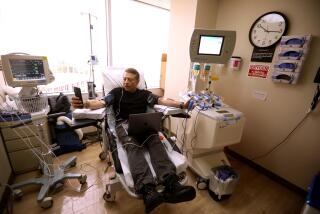Is It Snake Oil or a Medical ‘Miracle’?
- Share via
“A pure crock,” sneers one doctor.
“It’s not proven,” says another, but adds, “It’s also not unproven.”
Cautions a third: “There’s enough smoke to warrant a closer look.”
The subject of this medical debate is one of the hottest self-help books to hit the market in years. Barely a month after publication, more than half a million copies of “The Arthritis Cure: The Medical Miracle That Can Halt, Reverse and May Even Cure Osteoarthritis” (St. Martin’s Press, 1996) were sold and its principal author--Dr. Jason Theodosakis--has made scores of radio and television appearances, including “Today” and “PrimeTime Live.”
That’s not surprising.
Osteoarthritis, the common wear-and-tear form of the disease affects about 16 million Americans. It is characterized by the breakdown of the cartilage capping the end of the bones; symptoms range from mild discomfort and stiffness in the joints to crippling pain that severely limits movements.
*
“Miracle” arthritis cures abound, of course, and have included everything from copper bracelets to fish oil and bee venom. But medical science rejects them all. The only treatments it offers, apart from surgery, such as knee or hip replacements, or a shot of cortisone, are painkillers or non-steroidal anti-inflammatory drugs. Now, in “The Arthritis Cure,” Theodosakis, 34, who practices sports and preventive medicine in Tucson, Ariz., and teaches at the University of Arizona medical school, is promising much more.
Plagued by severe osteoarthritis himself, the result of a spate of sports injuries, he found no relief with conventional therapies.
“I endured ice packs, took anti-inflammatories and had my [damaged] meniscus removed by arthroscopic surgery, yet I was still in pain and still disabled,” he recalled.
So, in desperation, he searched the medical literature and came upon reports of an unorthodox treatment that had long been favored by some European physicians. It involved oral doses of either or both of two compounds--glucosamine and chondroitin sulfate. The compounds are found in the joints and other connective tissue, where they perform a dual function: glucosamine encourages the production of new cartilage, while chondroitin sulfate keeps enzymes from breaking old cartilage down.
“I was a scientist and a skeptic,” said Theodosakis, “so I really studied the treatment a long time before I tried it myself.” But when he finally did, the results were “amazing,” he said.
Within a few weeks, his pain subsided and he got off anti-inflammatories. Eager to spread the word, he started talking up the supplements among his family and patients.
Instead of waiting until a full-fledged study could be done, he decided he “had to get the message out.” The result was “The Arthritis Cure,” co-written by Los Angeles health writers Brenda Adderly and Barry Fox.
The initial printing of 100,000 copies sold out within three days, boosted by an endorsement from nationally syndicated New York Times health columnist Jane Brody, who disclosed she had not only used the supplements to treat her 11-year-old spaniel, but also took them herself. After two months, she wrote enthusiastically, her arthritic knees felt “about 30% better.” (Cost of her self-medication: $1.67 for three capsules a day.)
The reaction of arthritis experts is much more cautious.
“There’s no doubt healthy cartilage requires these molecules, but can you get them there by ingesting them orally?” asked Dr. Tim Spiegel, a rheumatologist at the Sansum Medical Clinic in Santa Barbara.
Added Dr. David A. Horowitz, chief of rheumatology and immunology at County USC Medical Center, “There is no good evidence that the stuff does anything.”
Some physicians also wonder how to separate the supposed benefits of the supplements from those of the other parts of Theodosakis’ nine-step “cure,” which includes such accepted measures as exercise, a balanced diet, weight control and stress reduction.
And they are especially irritated by the book’s title.
It’s “intentionally misleading,” insisted Dr. Doyt L. Conn, medical director of the Arthritis Foundation.
In defense of his use of the word “cure,” Theodosakis described the issue as a “philosophical” one.
“For most lay people,” he said, “if you have no more pain, no more signs of discomfort, essentially you feel cured.”
*
For all their doubts, however, some physicians aren’t quite ready to dismiss the supplements as just more arthritis quackery.
“We need to keep an open mind,” said Dr. Joseph B. Houpt, a clinical rheumatologist at Toronto’s Mount Sinai Hospital.
In an effort to explore the efficacy of the supplements and whether they are as benign as the book claims, a few double-blind studies are now underway, such as one recently started by Houpt involving 100 patients.
But what physicians really want is long-term studies on larger populations. Unfortunately, “that takes money--and you aren’t likely to get it from pharmaceutical houses because they have no proprietary interest in the supplements,” said Roland Moscowitz, chief of the rheumatic diseases division at Cleveland’s University Hospitals.
Nor is the U.S. Food and Drug Administration planning to step in, said a spokesman. Under a 1994 law, health claims can be made for “natural” food supplements--so-called nutraceuticals--without the FDA’s approval.






